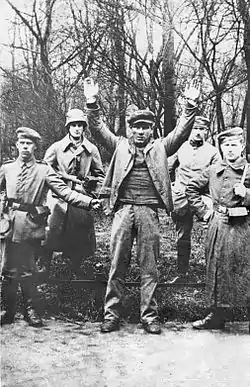Political violence in Germany (1918–1933)
Germany saw significant political violence from the fall of the Second Reich and the rise of the Weimar Republic through the German Revolution of 1918–19, until the rise of the Nazi Party to power in 1933 when a Nazi totalitarian state was formed and opposition figures were arrested. The violence was characterised by assassinations by and confrontations between right-wing groups such as the Freikorps (sometimes in collusion with the state), and socialist organisations such as the Communist Party of Germany.[1]
| Political violence in Germany (1918–1933) | ||||||||
|---|---|---|---|---|---|---|---|---|
| Part of the Interwar period | ||||||||
 Johann Lehner (*1901) photographed with government troops on May 3, 1919, moments before they murdered him because they had mistaken him for a Bavarian Soviet Republic official. | ||||||||
| ||||||||
| Belligerents | ||||||||
| ||||||||
| Commanders and leaders | ||||||||
|
|
|
| ||||||
Further reading
- Blasius, Dirk (2008). Weimars Ende. Bürgerkrieg und Politik 1930-1933 [The end of Weimar. Civil war and politics 1930-1933] (Paperback ed.). Frankfurt: S. Fischer Verlag. ISBN 978-3-596-17503-1.
- Brown, Timothy S. 2009. Weimar Radicals: Nazis and Communists Between Authenticity and Performance. Berghahn.
- Schumann, Dirk. 2009. Political Violence in the Weimar Republic, 1918-1933: Fight for the Streets and Fear of Civil War. Berghahn.
References
This article is issued from Wikipedia. The text is licensed under Creative Commons - Attribution - Sharealike. Additional terms may apply for the media files.